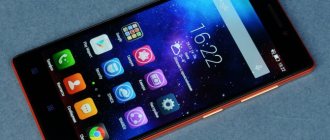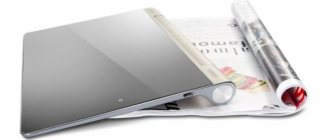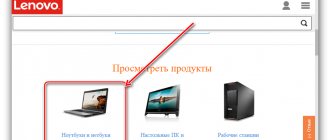Lenovo K900 – 2013 flagship with an Intel processor
Previously, we associated Lenovo primarily with laptops; they were of high quality and did not cause any complaints. Only a few have heard or seen telephones. Most considered this company’s development in the field of smartphones to be just an appendage to laptops, because many of us were already familiar with the term “Chinese smartphone on Android” and this discouraged the desire to purchase something from their model range.
And mobile phone retail chains were not in a hurry to bring phones from this company to our market. But the most demanding ones wanted to get quality at an affordable price, ordering goods directly from China. You can find out how to do this by studying our material called:
How to buy Lenovo P780 on Aliexpress.
But everything changed dramatically after the company released its flagship, workhorse of 2013 - the Lenovo K900 smartphone with an Intel processor. For many, this was a shock and new. People began to become interested in the company, and dealers got involved and began offering the IdeaPhohe model range in their retail chains. Actually, thanks to this model, most ordinary users learned about the existence of mobile phones from Lenovo. You can view the full list of devices and study their classification by reading the article:
Classification of Lenovo IdeaPhone device series
Let's take a closer look at what the Lenovo Ideaphone K900 smartphone is and find out why it might be of interest to us.
⇡#Design
One of the main features of the Lenovo K900 is the minimum thickness of the case: the official specifications list the figure as 6.9 mm. In some places the case is really that thin, but in a number of other places its thickness rises to 7.1 mm. Not that we think this difference is important, we just try to stick to the facts. In any case, the device is remarkably thin, which makes it relatively convenient to fit in your pocket. Well, as convenient as it can be in the case of a “megalopate” with a 5.5-inch diagonal and not the narrowest frame around the display.
But with the masses there is no deception at all. As stated in the official specifications, 162 grams is what it actually is, gram for gram. Coupled with the large horizontal dimensions of the case, this creates an interesting feeling of “weightlessness”: from the K900 you would expect it to be much heavier. So when you take it in your hands, you are surprised at how light it is.
The build quality is not perfect. For example, the SIM card tray in the Lenovo K900 we tested protruded by about half a millimeter. And since it is located in the place where you mainly hold your smartphone, the “burr” gets on your nerves: you want to take out a plane and straighten it. In addition, the black backing of the camera eye was inserted with a noticeable distortion.
Many manufacturers, more and more often, are trying to get rid of dedicated buttons, but Lenovo did not do this: in the K900, the buttons are completely separate, albeit touch-sensitive, with a neat lilac-blue backlight of exactly the brightness that is needed.
The design is based on a robust magnesium alloy chassis that is invisible on the surface. The display is attached to it on one side, and the motherboard and battery on the other side.
And on top of all this, what is perceived from the outside as a body is put on - a casing consisting of a plastic frame with a thin metal insert in the central part. The metal, to be honest, is not very suitable: thin, flimsy and not hard enough - it scratches quite easily.
Thanks to the magnesium frame, the rigidity of the body of the large device is quite high. And the absence of direct contact between metal parts and glass promises good chances for the latter to survive a fall.
⇡#Display
The Lenovo K900 display diagonal is 5.5 inches, the resolution is 1920x1080, like all current flagships, with the possible exception of the iPhone 5s. The dot density is not a record, but very high - exactly 400 dpi. There may be more, but there is no practical difference; the image in any case looks remarkably smooth, “printed”. The displays for the K900 are produced by LG (in case you're interested, the matrix model is LH550WF23-SD01 V01).
In the material dedicated to the best displays of MWC 2013, we called the Lenovo K900 screen the most contrasting of those that we were able to get acquainted with at the exhibition. The reality, however, is somewhat more prosaic: after more careful measurements and a longer acquaintance, it was discovered that the real contrast of the K900 display is much lower. The fact is that Lenovo, like many other manufacturers, uses a non-disabled optimization system that increases brightness in cases where the image is generally light, and decreases it when the picture is mostly dark.
Moreover, this system works in a rather original way. On the one hand, it greatly distorts the picture - significantly reducing the brightness of the backlight and adjusting the image displayed on the screen so that it looks approximately the same as the original - the difference, however, is not difficult to notice.
On the other hand, for most manufacturers such things work a little more intelligently, but generally everywhere. But Lenovo programmers, due to an overly aggressive adjustment algorithm that severely breaks the picture, had to make exceptions for those applications in which image quality is really important. That is, for video players and photo viewers.
As a result, if you test the display using a standard application (which is what we did at MWC), then the picture in it will be distorted, and the result of measuring the contrast will turn out to be absolutely cosmic - this time we measured as much as 1855:1. However, if you test the screen using a set of test images opened in the “gallery”, then everything falls into place: the contrast both on the combined images “50% white, 50% black” and on fully flooded screens turns out to be the same - an honest 800: 1 . Not as cool as using "magic", but still very good. Viewing angles, by the way, are also very, very good.
The maximum brightness of the display turned out to be slightly higher than in the test unit we dealt with in Barcelona - about 380 cd/ m2 . Since the display is equipped with a “trick” befitting flagship devices—a polarizing layer that reduces the level of illumination—this level of brightness is enough to work with a smartphone in the sun.
The display in serial smartphones is not configured in the best way. Let's say the color gamut triangle is greatly narrowed and noticeably distorted compared to the standard sRGB color space. And the white point went into the frosty blue-green distances.
Actually, the temperature is too high for all shades of gray, but an additional defect in the setting is that for the more critical light shades it is even higher than for the dark ones. As a result, the picture is very cold, this is especially visible when compared with something warm and lamp-like, like the iPhone 5c display.
The gamma curves also don’t look very good - they have a “boa constrictor that swallowed an elephant” shape that is quite typical for Asian smartphones. Of course, when compared with the display of the Sony Xperia Z, then everything is not so bad. However, the low quality of the “Z” screen is not what you should strive for.
As a result, the picture on the display does not look as great as it could, given the capabilities of the matrix: it is colder and somewhat more faded than necessary. Additionally, the optimization system mentioned above worsens the perception, severely breaking the image. Also, the color schemes are not very well thought out. For example, the main color for accents is Lenovo's favorite faded orange. And by default, the system has dark wallpaper - gray with red details. Wow.
Screen
The 5.5-inch screen with a resolution of 1920x1080 pixels and a high-quality IPS matrix is very impressive. The viewing angles are pleasing - the picture looks good from almost any angle. The screen is made using Gorilla Glass technology, so it survives all drop tests with dignity.
There is no backlash or screen sagging effect when pressed hard. The multi-touch test, as with most modern smartphones, showed support for 10+ touches on the screen.
⇡#Technical characteristics
| Lenovo IdeaPhone K900 | |
| Display | 5.5 inches, 1920×1080, IPS |
| Touch screen | Capacitive - up to 10 simultaneous touch points |
| Air gap | No |
| Oleophobic coating | Eat |
| Polarizing filter | Eat |
| CPU | Intel Atom Z2580: dual Saltwell cores (x86), 2.00 GHz; process technology 32 nm HKMG |
| Graphics controller | Imagination Technologies PowerVR SGX544 MP2, 533 MHz |
| RAM | 2 GB LPDDR2 |
| Flash memory | 16 GB (2+10 GB available) |
| Connectors | 1 x Micro-USB 2.0 1 x 3.5mm headset jack 1 x Micro-SIM |
| cellular | Intel XMM 6360 platform (PMB9820 + PMB5745): 2G: GSM/GPRS/EDGE 850/900/1800/1900 MHz 3G: DC-HSPA+ (42 Mbps) 850/900/1700/1900/2100 MHz 4G: not supported Micro-SIM |
| WiFi | 802.11a/b/g/n (Broadcom BCM4330) |
| Bluetooth | 4.0 |
| NFC | No |
| IR port | No |
| Navigation | GPS, A-GPS, GLONASS |
| Sensors | Light sensor, proximity sensor, accelerometer/gyroscope, Hall sensor (digital compass) |
| Main camera | 13 MP (4096×3072), autofocus, dual LED flash |
| Front-camera | 2.0 MP (1920x1080), without autofocus |
| Nutrition | Non-removable battery 9.5 Wh (2500 mAh, 3.8 V) |
| Size | 157×78 mm Case thickness 7.1 mm |
| Weight | 162 g |
| operating system | Google Android 4.2.1 (Jelly Bean) Lenovo's own shell |
| recommended price | 16,990 rubles |
Cameras
The smartphone comes with two cameras, a main one with a resolution of 13 MP and an f/1.8 aperture, and a front one with a resolution of 2 MP and a viewing angle of 88°.
The viewfinder interface contains a translucent strip (on the right) with a shooting button, a photo-video mode switch and an icon for entering the gallery. You can also view the captured material by swiping across the screen from right to left. The top strip of the screen is occupied by icons, the far right is responsible for calling up shooting modes, including panorama, HDR, macro, etc., as well as advanced ones: motion removal, smart shot (for group photos), GIF and magic GIF. The last four are reimagined shooting modes in Nokia WP smartphones. An unpleasant feature of the Lenovo K900 camera is that in all modes, with the exception of regular photos, the image resolution is set at 6 MP if 9 MP is selected for regular photos, 16:9 ratio, and 5 MP if the maximum resolution of 13 MP is selected with aspect ratio 4:3. In addition to shooting modes, the user is offered a choice of 24 different effects, but working with them is accompanied by noticeable slowdown, so they are unlikely to be used often.
Video recording can be done with flash, there is image stabilization and a choice of white balance.
You can evaluate the quality of photos and videos using the examples below.
Example of Full HD video shot by Lenovo Ideaphone K900
⇡#Iron and communications
The Lenovo device has a rather indirect relationship to that smartphone on the Intel platform that we reviewed a few months earlier - let us remind you that we are talking about the Prestigio MultiPhone PAP5430. Although both of these models are based on Intel processors, the chips themselves are of a fundamentally different level. In the case of Prestigio, we were dealing with last year's platform, which was further slowed down for the sake of cost reduction - the Atom Z2420 system-on-chip. This time we have the flagship processor of the most modern version available for smartphones, the Atom Z2580.
The difference is dramatic. To begin with, instead of one x86 core (Saltwell) the Z2580 has two. And since Atom processors have 512 KB of cache memory per core, the cache is correspondingly twice as large. And the megahertz is not at all the same: the dynamic frequency change bar in the Z2420 was set at 1.2 GHz, while in the Z2580 it is a much more impressive 2 GHz.
Intel Inside - Lenovo Outside
The graphics core built into the processor has noticeably changed: the Z2420 was equipped with a weak PowerVR SGX545, operating at a frequency of 400 MHz; in the Z2580, the adapter was changed to a dual-core SGX544 MP2, which operates at a frequency of 533 MHz. The “brute force” in the new version is several times greater - 38.4 versus 6.4 GFLOPS. In practice, of course, everything is not so magical, but still these numbers give some idea of the seriousness of the changes.
Now a little about what these processors have in common - besides the architecture of the computing cores. Both of them are produced using the not-so-new 32 nm HKMG process technology available from Intel (Bay Trail, we're waiting for you and your 22 nm!). The memory controller has also not changed: in both cases the processor works with dual-channel LPDDR2. True, the volume of RAM soldered onto the processor case in the case of the Z2580 is twice as large - 2 GB.
As for the drive, the Lenovo K900 has only one option: 16 GB of built-in eMMC flash memory, of which 10 GB is available to the user (plus another 2 GB on a separate system “drive”). For some reason, Lenovo decided in this case to deviate from the glorious Chinese tradition of building everything possible into a smartphone - including a TV, microwave and washing machine - and did not equip the K900 with a MicroSD card reader. So it won't be possible to expand the drive.
The smartphone can connect to a computer using the MTP (Media Transfer Protocol) and PTP (Picture Transfer Protocol) protocols, and as a regular USB drive. In the latter case, however, the internal 10-gigabyte “flash drive” for data becomes inaccessible from the smartphone while connected to the computer. You won't be able to listen to music while downloading new music in this option - this is just an example.
The drive is not accessible from a smartphone when connected to a computer - you can’t even take a screenshot
This year there was a celebration on the Intel street - the company managed to get its radio module into one of the best-selling smartphones in the world, Samsung Galaxy S4 (though only in the version without LTE - but also not bad). It is difficult to imagine that in such circumstances a “central” device with an Intel processor would receive communication from another manufacturer. This did not happen - the Lenovo K900 uses exactly the same platform as the “worldwide version” of the SGS4: Intel XMM 6360.
It consists of two chips: an Intel PMB9820 modem and a PMB5745 transceiver - the latter supports the standard “quartet” of 2G bands and five 3G bands, that is, it is quite omnivorous for a chip whose purpose is to provide exclusively third-generation communications. Since there is no support for LTE and was not intended, all the necessary bands in this case are served by a single signal amplifier (Skyworks 77615, in case you were wondering).
The “SIM receiver” is sensitive to the correct orientation of the card - in our case, the smartphone refused to work with a pair of crookedly cut (factory, not homemade) micro-SIM from MTS
The Intel modem does not have a built-in GPS receiver. We couldn’t find out which solution is being used, but it’s safe enough to assume that in this case Intel/Lenovo used the same chip as Intel/Samsung - BCM4752, which supports GPS and GLONASS. This assumption looks all the more plausible since the K900 uses a Wi-Fi adapter from this manufacturer. One way or another, GPS works very quickly and accurately - at least no worse than on smartphones with the latest generations of Qualcomm chips.
30 seconds after a cold start - this result was obtained on the balcony of an apartment building
Equipment
The device comes in a stylish small box, which is typical for Lenovo, but in this case the box itself looks more stylish than with budget models - this already indicates that there will be something interesting inside.
In addition to the phone in the box, we can see documentation, a paperclip for removing the SIM card, a charger, a microUSB cable, an adapter for a Euro socket and an audio headset.
⇡#Performance
The Atom Z2580's processor cores are quite fast - not fast enough to outpace the super-powerful Snapdragon 800, but at least they manage to keep pace with last year's Qualcomm flagship, the APQ8064 chip.
The strength of the Intel chip is its high performance in Javascript tests. In these tasks, the chip confidently outperforms APQ8064. Although the current Qualcomm flagship is still too tough for him.
Linpack for Android traditionally rates the capabilities of Atom chips very low - most likely, questions here should be asked not to Intel, but to the creators of this test.
The last processor test is a physics test from the 3DMark package. Here everything is about the same as in other benchmarks: Atom is faster than APQ8064, but noticeably slower than MSM8794.
If the Atom Z2580 is doing quite well with processor performance, then with graphics it’s not so great. Both the Adreno 320 adapter built into the APQ8064 and the even more powerful and new Adreno 330 integrated into the Snapdragon 800 show significantly better results.
The specific advantage of Qualcomm accelerators varies from test to test, but the overall picture does not change - the dual-core PowerVR SGX544 MP2 built into Atom is not able to catch up with its competitors.
Total: four in processor performance, three in graphics performance. Not the best combination for a smartphone with Full HD display resolution. In the new generation of Atom, everything will be much better - but you still have to wait: chips for tablets will appear first, and only after everything has been tested on larger devices will it come to smartphones.
What about the owners?
The Lenovo K900 smartphone turned out to be a very balanced solution. Reviews from the owners of the gadget highlight a number of advantages: an impressive amount of built-in and RAM memory, a powerful processor, a high-quality screen, and a reliable and protected case. This smartphone has certain problems only with autonomy and processor heating. But, as was previously said, the first issue is easily resolved with the help of an additional external battery. In the second case, all you need to do is set the CPU operating mode correctly - and the semiconductor crystal will not overheat.
⇡#Software
At the moment, Lenovo K900 is the only smartphone on the Intel platform that runs the current version of the Android operating system - 4.2.2. The Prestigio PAP5430 we reviewed in August, for example, was equipped with the ancient 4.0.4 at the time sales began - and there is still no update to a more decent version.
The operating system interface has been significantly redesigned by Chinese programmers. Actually, when it comes to branded shells, Chinese doesn’t necessarily mean “bad.” But in this case, the “launcher” leaves much to be desired. From how it looks to how it works.
Making a processor as strong as the Intel Atom Z2580 slow down is probably not an easy task. But the Chinese comrades managed to accomplish it! An honest pioneer, when it comes to the operation of the standard interface, the Lenovo K900 is the most thoughtful of all the smartphones we have dealt with this year.
The brakes are especially noticeable in two cases. Firstly, when leisurely scrolling through the settings menu, movement occurs with completely indecent jerks. Secondly, immediately after unlocking the device: if you try to move to the adjacent desktop screen immediately after this, you will often have to wait up to a second for the system to “unlock”. In third-party applications, things are a little better, but the same Google maps also do not work as smoothly as on smartphones with Qualcomm processors.
Go ahead. The notification panel drop-down menu is not designed in the most convenient way. One-touch access is only available to five functions, which the user is not allowed to select independently. To get to the rest, you will have to press at least one more button. And for access to settings - too. Although what prevented you from placing this ill-fated gear on the first screen?
Managing shortcuts on the desktop is also done a little strangely. If you perform a standard action - touch a shortcut and hold your finger - a pop-up menu will appear next to it. But if you select the “delete” option in this menu, then – surprise, surprise! - you will not delete the shortcut; instead, you will completely erase the entire application from your smartphone. And to remove a shortcut, you need to drag it onto an inconspicuous inscription at the top of the display. Moreover, if you “release” the icon, the pop-up menu will remain, but the treasured inscription will not. So it’s even easier to get confused than it might seem.
The settings are not the most obvious and not the most convenient way, divided into three tabs. Something is missing - for example, the “Energy consumption” item, where you can usually see a graph of battery consumption, is completely missing.
And all because for all “electrical” questions you need to contact a separate proprietary Lenovo Power application (in Russian translation “Lenovo Power”) - however, there is no schedule in it either.
Among the tricks that the Chinese taught the device, the following should be noted: firstly, the smartphone can be locked by shaking and unlocked by double tapping. Secondly, the K900 can detect when it is in your pocket and increase the ringer volume in this case - and vice versa, lower it if the device is removed from your pocket. Thirdly, you can turn on your smartphone not only by pressing the power button or tapping, but also by pressing the volume control buttons.
Despite these useful additives, we give the Chinese a “failure.” We are not big fans of “naked Android,” but if we had to choose between Lenovo’s “launcher” and the standard interface of the Google operating system, we would definitely choose the latter. Because the Lenovo shell turned out to be ugly, uncomfortable, not worked out in detail, wildly slow and not very comfortable.
⇡#Camera
The Lenovo K900 uses a camera with a resolution of 13 megapixels - we can assume that here, like most flagship devices this year, a Sony back-illuminated sensor is used. Whether this is true or not is not very clear. But the main thing you need to know is that the camera is very, very good
The camera application is proprietary - with a more convenient interface than the standard Android one, and a significant number of manual settings.
A number of filters and several additional modes are supported - HDR, night photography, continuous shooting ("Explosion", yeah) and so on. To leave any of these modes, you must press the “OK” button—the worthy heirs of Mao do not recognize any other actions as a valid reason for leaving the special mode. Well, at least you drew a hint, thanks already.
Now let's see what the camera is capable of. We will compare it with the Sony Xperia Z - after the release of Zetadine, this device has noticeably fallen in price and is closer in price to the Lenovo K900, although it still costs a little more.
With the most favorable lighting - when shooting in summer in sunny weather - the cameras show approximately the same results. There is a noticeable difference in color rendition, but it’s hard to say whether the Xperia Z or the Lenovo K900 handles photography better.
However, even here there are nuances. Lenovo's post-processing tends towards sharper details. But it often makes mistakes with color: for example, in a test frame taken on the K900, the pattern of green diamonds almost disappeared from the roof of the cathedral - although Sony blurred the picture more, it kept the details as they should be.
Greater clarity and higher contrast - this is the motto of the programmers who developed image processing algorithms for the Lenovo K900.
We would like to combine the next couple of frames in one picture: take the clear and more richly “painted” car from the Lenovo picture, and the correctly processed background from the Sony picture.
From HDR I would also like something in between what Sony does and what Lenovo does. The Chinese version of HDR is much more aggressive: it reduces the frame resolution to 5 megapixels, is very blurry and makes the colors completely unnatural. In addition, the HDR in the K900 is quite mediocre - therefore, there is a higher chance of blurring the photo. The Japanese, however, are not doing well either: the image in this mode loses a lot of contrast.
But HDR from the Chinese has one nice feature: the result varies greatly depending on the focus point. And what’s especially nice is that it’s clearly visible in the viewfinder. Well, the way HDR works for the Japanese is very reminiscent
Steven Seagal.
As a result, if you play around with focusing, you can often get a pretty decent HDR photo on the K900.
Although sometimes it turns out completely “caramel tin”.
Night mode works almost the same as HDR - it also reduces the resolution to 5 megapixels, it also blurs wildly and raises the contrast. Since it is easier to ruin a photo at night than during the day, you should use it carefully. Or don’t use it at all - there’s not much use for it.
The Lenovo K900 camera app can take panoramas. The direction of movement is selected automatically (although the axis - horizontal or vertical - will have to be set manually). The application is quite strict about user actions: if you move the camera too quickly, the program will require you to “return to”.
You can stop shooting at any time - while Sony smartphones require you to “go to the end.” The resolution does not decrease as much as in many other panoramic shooting systems - about one and a half times in height. The smoother you move the camera, the higher the resolution of the final image will be.
The camera can shoot video with a resolution of up to 1920x1080, but without HDR support, which is no wonder with such an aggressive algorithm.
The result of the shooting compares with videos shot on the Xperia Z in much the same way as photographs: the clarity is noticeably higher, but serious errors occur with color rendition. Let's say, in our case, the azure color of the water was completely lost, and the forest turned spotty instead of green - some trees were “dragged” into blue, others into yellow.
On the left is a video shot on a Sony Xperia Z, on the right - on a Lenovo K900
However, if you don’t quibble and remember what price category the device falls into on the Russian market, the camera is not just good, but downright wonderfully and surprisingly good. It will be difficult to find another smartphone for the same money with such shooting quality.
⇡#Battery
The smartphone is equipped with a non-removable battery with a capacity of 9.5 Wh (2500 mAh, 3.8 V). In fact, a more capacious battery could fit into the spacious case, but for this it would be necessary to work hard on miniaturizing the motherboard - and Lenovo engineers apparently did not set such a task.
Since the K900, among other things, is equipped with a large and power-hungry display, its operating time is inferior to many other devices. Let's say that in video playback mode, the Lenovo K900 performs a little less than the Xperia Z - and much less than the Xperia Z1. This despite the fact that the battery capacity of Japanese smartphones is 8.7 and 11.1 Wh, respectively. The final power consumption of the Lenovo K900 in this mode is a little more than 2 W, while for a couple of Sony smartphones it is 1.7-1.8 W.
If you overload the processor with work, the result becomes even more disastrous: in the harsh AnTuTu battery test, the Chinese smartphone turns out to be a clear outsider, even despite the fact that the display brightness in this application is noticeably reduced by the image adjustment system.
You should also keep in mind that a smartphone generates a significant portion of the energy it consumes in the form of heat - and since the case is metal, the heat is really noticeable to the touch. Graphite heatsinks placed inside the case above the processor help to slightly reduce the heat, but still, under load, the smartphone heats up quite noticeably.
In general, the device does not belong to the family of long-livers. Even with moderate use, the Lenovo K900 will only last until the evening. If you use your smartphone actively - play games, watch movies, often turn on navigation - especially from Yandex - and use a lot of data transfer, then you should carry a charger with you. It will definitely come in handy.
Contents of delivery
The smartphone comes in a black package slightly larger than the device itself. On the front of the box there is an embossed Lenovo logo and K900 cut out in cardboard. The inside of the outside of the package is glossy and painted red. This creates an extra WOW effect as soon as you start moving it in relation to the main part of the packaging. Underneath is a box of a more familiar design with a velvet-like coating. There is also a manufacturer's logo, model index and the inscription Intel inside. Inside the box is a smartphone. Here it is already in close contact with the edges of the package. In order to remove it from the niche, a special tongue is provided. Inside the tray on which the smartphone is located, there is a warranty card and operating instructions, and on the back there is a clip for removing the SIM card slot. In the remaining part you can find a simple headset, a USB cable and a 2 A mains charger. Under each of these accessories there is a picture corresponding to it.
As already mentioned, the packaging clearly hints that something expensive and stylish is waiting for you inside. Which, in principle, corresponds to reality, although a simple headset stands out from the overall picture.
⇡#Conclusions
Alas, in combination with a Full HD display and Chinese software, the Intel Atom Z2580 processor turned out to be surprisingly leisurely - or rather, thoroughly slow. In addition, the Lenovo K900 drains the battery noticeably faster than we would like - and gets very hot in tasks in which the processor is used to its fullest.
However, this is not to say that the smartphone is no good. It is equipped with a really good, although not quite correctly configured, display and a very good camera. We would not recommend buying it as your main device - there is a very high chance of being left without communication at the most inopportune moment due to a suddenly empty battery. But for those who stick to the "small and long-lasting phone for calls + big shovel for the Internet" combination, the Lenovo K900 is a pretty interesting proposition. After all, few people offer such a smartphone for such money.







